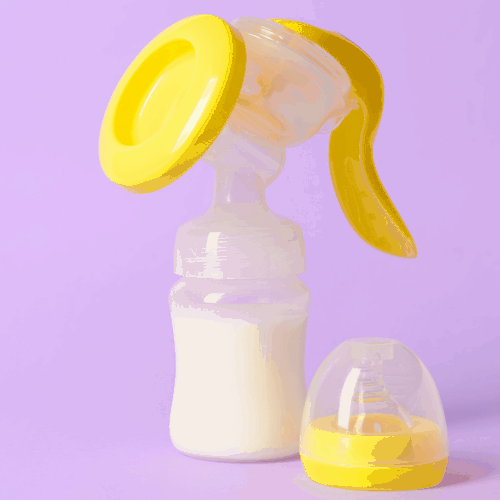Making the decision to breastfeed your baby is wonderful. Breastfeeding has numerous benefits for both mother and baby and can lead to a bonding relationship like no other.
However, there are things to think about and not everyone has an easy ride with breastfeeding. Some moms choose to move to formula feeding and some moms express their breastmilk with a pump to feed baby from a bottle, some may even do a combination of all three.
There are no right or wrong ways to feed your baby as long as everyone is happy and thriving.
As an Amazon Associate I earn from qualifying purchases. The links below may be affiliate links. Please read my disclosure policy for more information.
Benefits of Breastmilk
The World Health Organization recommends breastfeeding until the age of 2 years or longer, this is because the benefits last that long.
However, if you can’t or don’t want to breastfeed, you can still give your baby your breastmilk by expressing with a pump or you can mix the two methods to fit in with your needs.
Possibly the most important thing to understand is that your breastmilk is naturally tailored to provide the ideal nutrition for your baby at any given stage.
The colostrum your breasts produce shortly after birth is the ideal, rich milk that is perfect for babies in their first few days as it is dense in nutrients for newborn tummies, some people refer to it as liquid gold! This milk is invaluable regardless of whether it’s given in a bottle or from the breast.

There have been suggestions that breastfed babies are less susceptible to certain illnesses; Gut infections, Allergies, and Respiratory illnesses are amongst some of the things that may be a reduced risk in babies who are exclusively fed breastmilk.
Your milk is packed with antibodies that get passed on when feeding and help to protect the baby from viruses and bacteria.
Statistically, babies who are fed breastmilk are less likely to be obese in later life and less likely to have cardiovascular disease in adulthood.
Breastfeeding is also easier on the bank balance, no formula to buy and prepare means more money stays in Mom and Dad’s pocket, plus breastmilk once established, is always available and always just what your baby needs.
When to feed and how much?
Women all follow their own plans when feeding their babies, and that’s the perfect approach. Some offer a feed whenever baby needs soothing and are led by their baby, this is called feeding on demand, on the other hand, some prefer to stick to a schedule to fit in with nap times and other commitments like other children, work, or social commitments.
Women who are going back to work soon after the baby is born can choose to express with a pump to allow their baby to continue having breastmilk while they’re with a childcare provider.
Many offices now provide spaces for moms to pump during work breaks. There are options and methods to fit all families.
There is no method that is better than another, as long as Mom is comfortable and baby is gaining weight and thriving, that’s all that matters. Fed is best.

To Pump or Not to Pump?
Not every new Mom uses a breast pump, and that’s fine. If you do however then that is great.
There are numerous benefits of pumping milk, so let’s explore a few.
Letting other people feed the baby
If you need a break, need to go back to work, or simply want to give someone else the experience of feeding your precious bundle, then pumping milk for a bottle will allow for that. It can be combined with breastfeeding or done exclusively.
Schedule feedings
If you’re a parent who wants to feed your baby on a schedule, then pumping can facilitate that as you can pump to fit the timings of the feeds and see exactly how much milk the baby is consuming.
Bottle feedings
Babies who struggle to latch onto the breast for whatever reason benefit from having Mom’s milk but in a form in which they can take, in this case, a bottle.
Nipple break
Equally, mothers who are experiencing sore, cracked nipples can get a break from feeding if the baby is having its pumped milk from a bottle.
Breastmilk benefits for premature babies or ones still in the hospital
Babies who are premature or need hospital care can still benefit from breastmilk by having it expressed and fed to them whilst receiving treatment.

Pumping on a Schedule
If you choose to pump exclusively to a schedule then what does that look like? How often should you pump and how far in advance?
Pumping as early as possible after delivery can help to encourage your milk supply to come in and can give you a good bank of milk to keep stored if you need to go back to work or simply want to keep a supply stored for later. It will also extract the precious colostrum for your baby to benefit from.
Generally, you’ll get most milk in the morning so that’s a good time to pump.
Aiming for around 10 pumping sessions in 24 hours is a good starting point after delivery and until your milk is fully established and you’re getting a plentiful and regular supply.
Once this happens you can work your pumping schedule, however, works best for you but try to make sure you’re getting similar volumes each day and avoid going down to just one session per day as this can be problematic for supply.
Make sure to alternate which breast you pump from if using a single pump to prevent soreness and discomfort, if you plan to exclusively express then using a double pump is a good option if you want to express to go quicker.
Using a decent electric breast pump will help you maintain your flow effectively as it mimics your baby’s natural suckling motions. Reading reviews from other moms is the best way to find a quality pump.
There are so many on the market, a wide range of different prices and sizes; some will be discreet and quiet and fit into your bra for a hands-free option, some will be more robust and pump quicker and more effectively. It really is your preferences that matter.
You’ll find like everything in life, practice makes perfect. The more you pump, the quicker and easier it will become.
Some top tips for success are making sure you’re relaxed, comfortable, and have access to snacks and a drink, and be sure to try when you have plenty of time, don’t rush!
Get to know what works best for your body.
Read the literature that comes with the pump and have a look at all the settings and equipment, getting to grips with your pump can prove invaluable over the months to come.
It is good to get in the habit of writing down the amounts you’re getting each time you pump and keep a daily or weekly total, this way you can quickly see if your supply drops or changes significantly.
Taking this information to a lactation consultant can be helpful if you’re finding you have concerns.

What to do if Your Milk Supply Drops?
The first thing to do is to try and act quickly, it is easier to recover a supply that’s recently dropped compared to one that has been low for a while.
Consider seeing a lactation consultant who is an expert in breastmilk supply, pumping, and feeding. In the meantime, you can do the following:
- Increase the number of pumping sessions to 10-12 per day, keeping the pump in an easily accessible place will make this easier.
- Pump for longer, once the let-down reflex has finished and the milk has stopped flowing, go back to the beginning and see if you can stimulate another round, but be careful not to make yourself sore.
- Keep an eye on your fluid intake and try not to worry, there is plenty of support available for you and our baby.
Making a Schedule
It’s been suggested that having a visible pumping schedule in your life can help you and those around you to know when it’s time to pump.
A simple schedule on the wall or on an app for your phone is all it takes. Work out how many minutes per day you want to pump for and divide it by the number of sessions you’re aiming for.
For a newborn baby, aim for 2-3 hours between pumping sessions at first and try for 10 sessions in 24hrs making sure to leave some gaps for sleeping.
An example of this is. 6am, 8am, 10am, 12pm, 2pm, 5pm, 8pm, 11pm, 2am, 5am.

As you get more confident, and your baby gets older you can reduce this to suit and schedule 8, 6, 4, etc, keep an eye on volume and pump for longer each time to keep the same supply up.
It sounds complicated at first, but you’ll find you get into a routine that suits you and your baby. Go easy on yourself though, having a baby is tiring, especially when you have a life to lead as well.
It’s trial and error and a late or early session with the pump now and again won’t cause issues, if you feel you regularly miss sessions or that your schedule isn’t working anymore, then think about readjusting it to one that does.
Whatever you decide, hang in there and do what works for you. You’ve got this Mom.








